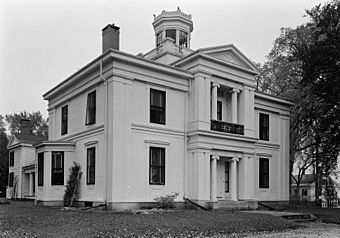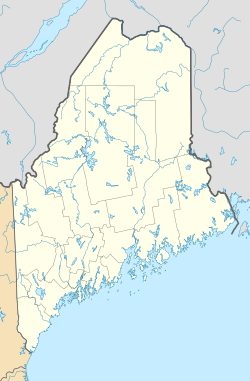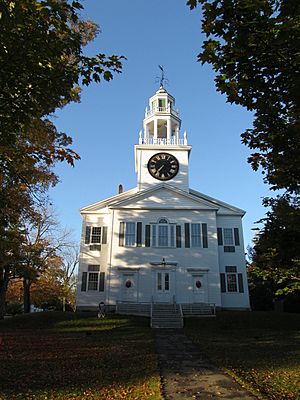Church Street Historic District (Belfast, Maine) facts for kids
|
Church Street Historic District
|
|
|
U.S. Historic district
Contributing property |
|

The James P. White House, 1960 HABS photo
|
|
| Location | Irregular pattern along Church St. from High to Franklin Sts., Belfast, Maine |
|---|---|
| Area | 30 acres (12 ha) |
| Architect | Calvin Ryder, others |
| Architectural style | Greek Revival, Federal, Italianate |
| Part of | Belfast Historic District (ID86002733) |
| NRHP reference No. | 78000331 |
Quick facts for kids Significant dates |
|
| Added to NRHP | November 28, 1978 |
| Designated CP | August 21, 1986 |
The Church Street Historic District is a special area in Belfast, Maine, where many old and important homes are protected. It's like a neighborhood museum! This district covers about 30 acres (about 12 hectares) and includes houses built from the early 1800s to the early 1900s. These homes show how Belfast grew and changed over time. The district was added to the National Register of Historic Places in 1978. This means it's recognized as a very important historical place in the United States. It's also part of a bigger area called the Belfast Historic District.
Contents
What Makes Church Street Special?
The city of Belfast is located on Penobscot Bay in Maine. After the War of 1812, Belfast became a busy port for shipping and building ships. As the 1800s went on, the city's economy grew in many ways.
Church Street was known as the most fashionable place to live in Belfast. It runs south from the city's main downtown area. It's also a few blocks away from the busy waterfront. Because it was such a popular spot, the street is lined with many beautiful, high-quality houses.
Popular House Styles
Most of these homes were built in the first 75 years of the 1800s. They show off popular styles from that time. These include the Federal, Greek Revival, and Italianate styles.
- Federal style: This style was popular in the early 1800s. Homes often have simple, elegant designs with balanced windows and doors.
- Greek Revival style: Popular in the mid-1800s, these homes look like ancient Greek temples. They often have tall columns and grand entrances.
- Italianate style: Later in the 1800s, this style became popular. Italianate homes often have low-pitched roofs, wide eaves, and tall, narrow windows.
These impressive houses were built by important people in Belfast. They were home to sea captains, shipbuilders, and successful business owners. All these people helped Belfast's economy grow and thrive.
Exploring the District's Boundaries
The Church Street Historic District includes many homes. On the west side of Church Street, it covers all houses between High and Miller Streets. On the east side, it includes homes between Spring and High Streets.
The district also extends to some houses on the west side of High Street, north of Church Street. Plus, it includes two blocks of Court Street. Court Street runs next to Church Street, and these blocks are between Franklin and Miller Streets.
The northern end of the district is marked by the First Church of Belfast. This church was built in 1818 and is one of two churches in the area. At the southern end, you'll find the James P. White House. This is a beautiful Greek Revival style house built in 1840.
Famous Architects and Houses
The James P. White House was designed by Calvin Ryder. He was a local architect whose work can be seen all over the district. Another impressive house designed by Ryder is the Williamson House at 18 Church Street. It's a very handsome Greek Revival house with a grand "temple front" design.




